Slavs
This articleneeds additional citations forverification.(April 2022) |
| Total population | |
|---|---|
| see§ Population | |
| Regions with significant populations | |
| Languages | |
| Slavic languages | |
| Religion | |
| MostlyChristianity (Orthodox·Catholic·Protestant·Spiritual) Minorities: Non-religious·Sunni Islam·Slavic paganism(neopaganism) | |
| Related ethnic groups | |
| OtherEuropean peoples |
TheSlavsorSlavic peopleare groups of people who speakSlavic languages.Slavs are geographically distributed throughout the northern parts ofEurasia;they predominantly inhabitCentral Europe,Eastern Europe,andSoutheastern Europe,though there is a large Slavic minority scattered across theBaltic states,Northern Asia,andCentral Asia,[1][2]and a substantial Slavic diaspora in theAmericas,Western Europe,andNorthern Europe.[3]
Early Slavslived during theMigration Periodand theEarly Middle Ages(approximately from the 5th to the 10th century AD), and came to control large parts ofCentral,EasternandSoutheast Europebetween the sixth and seventh centuries. Beginning in the 7th century, they were graduallyChristianized.By the 12th century, they formed the core population of a number of medieval Christian states:East Slavsin theKievan Rus',South Slavsin theBulgarian Empire,thePrincipality of Serbia,theDuchy of Croatiaand theBanate of Bosnia,andWest Slavsin thePrincipality of Nitra,Great Moravia,theDuchy of Bohemia,and theKingdom of Poland.
Beginning in the mid-19th century, apan-Slavicmovement has emphasized the common heritage and unity of all the Slavic peoples. The main focus of the movement was in the Balkans, whereas theRussian Empirewas opposed to it.
The Slavic languages belong to theBalto-Slavic branchof theIndo-European language family.Present-day Slavs are classified into three groups:[4][5][6][7][8][9]
- theWest Slavs(chieflyCzechs,Kashubians,Poles,Slovaks,SilesiansandSorbs);
- theEast Slavs(chieflyBelarusians,Russians,Rusyns,andUkrainians);
- theSouth Slavs(chieflyBosniaks,Bulgarians,Croats,Gorani,Macedonians,Montenegrins,Serbs,andSlovenes).
Though the majority of Slavs areChristians,some groups, such as the Bosniaks, mostly identify asMuslims.Modern Slavic nations and ethnic groups are considerably diverse, both genetically and culturally, and relations between them may range from "ethnic solidarity to mutual feelings of hostility" — even within the individual groups.[10]
Ethnonym
[edit]The oldest mention of the Slavicethnonymis from the 6th century AD, whenProcopius,writing inByzantine Greek,used various forms such asSklaboi(Σκλάβοι),Sklabēnoi(Σκλαβηνοί),Sklauenoi(Σκλαυηνοί),Sthlabenoi(Σθλαβηνοί), orSklabinoi(Σκλαβῖνοι),[11]and his contemporaryJordanesrefers to theSclaveniinLatin.[12]The oldest documents written inOld Church Slavonic,dating from the 9th century, attest the autonym asSlověne(Словѣне). Those forms point back to a Slavicautonym,which can be reconstructed inProto-Slavicas*Slověninъ,pluralSlověne.[citation needed]
The reconstructed autonym*Slověninъis usually considered a derivation fromslovo( "word" ), originally denoting "people who speak (the same language)", meaning "people who understand one another", in contrast to the Slavic word denoting "German people",namely*němьcь,meaning "silent, mute people" (from Slavic*němъ"mute,mumbling "). The wordslovo( "word" ) and the relatedslava( "glory, fame" ) andsluh( "hearing" ) originate from theProto-Indo-Europeanroot*ḱlew-( "be spoken of, glory" ), cognate with Ancient Greekκλέος(kléos"fame" ), as in the namePericles,Latinclueō( "be called" ), and Englishloud.[citation needed]
In medieval and early modern sources written in Latin, Slavs are most commonly referred to asSclavenior the shortened versionSclavi.[13]
History
[edit]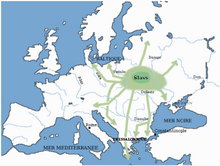
Origins
[edit]First mentions
[edit]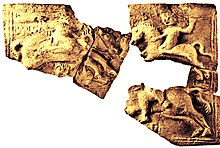
Ancient Roman sources refer to theEarly Slavicpeoples asVeneti,who dwelt in a region of central Europe east of theGermanictribe ofSuebi,and west of the IranianSarmatiansin the 1st and 2nd centuries AD,[15][16]between the upperVistulaandDnieperrivers. The Slavs under name of theAntesand theSclavenifirst appear inByzantinerecords in the early 6th century. Byzantine historiographers under emperorJustinian I(527–565), such asProcopius of Caesarea,JordanesandTheophylact Simocattadescribe tribes of these names emerging from the area of theCarpathian Mountains,the lowerDanubeand theBlack Sea,invading the Danubian provinces of theEastern Empire.[citation needed]
Jordanes, in his workGetica(written in 551 AD),[17]describes the Veneti as a "populous nation" whose dwellings begin at the sources of the Vistula and occupy "a great expanse of land". He also describes the Veneti as the ancestors of Antes and Slaveni, two early Slavic tribes, who appeared on the Byzantine frontier in the early 6th century.
Procopius wrote in 545 that "the Sclaveni and the Antae actually had a single name in the remote past; for they were both calledSporoiin olden times ". The nameSporoiderives fromGreekσπείρω ( "tosow"). He described them as barbarians, who lived under democracy, believed in one god," the maker of lightning "(Perun), to whom they made a sacrifice. They lived in scattered housing and constantly changed settlement. In war, they were mainlyfoot soldierswith shields, spears, bows, and little armour, which was reserved mainly for chiefs and their inner circle of warriors.[18]Their language is "barbarous" (that is, not Greek), and the two tribes are alike in appearance, being tall and robust, "while their bodies and hair are neither very fair or blond, nor indeed do they incline entirely to the dark type, but they are all slightly ruddy in color. And they live a hard life, giving no heed to bodily comforts..."[19]
Jordanes described the Sclaveni having swamps and forests for their cities.[20]Another 6th-century source refers to them living among nearly-impenetrable forests, rivers, lakes, and marshes.[21]
Menander Protectormentions aDaurentius(c. 577–579) who slew anAvarenvoy of KhaganBayan Ifor asking the Slavs to accept the suzerainty of the Avars; Daurentius declined and is reported as saying: "Others do not conquer our land, we conquer theirs – so it shall always be for us as long as there are wars and weapons".[22]
Migrations
[edit]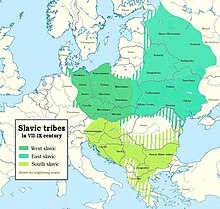
According to eastern homeland theory, prior to becoming known to theRomanworld,Slavic-speaking tribes were part of the many multi-ethnic confederacies ofEurasia– such as the Sarmatian, Hun and Gothic empires. The Slavs emerged from obscurity when the westward movement of Germanic tribes in the 5th and 6th centuries AD (thought to be in conjunction with the movement of peoples from Siberia and Eastern Europe:Huns,and laterAvarsandBulgars) started thegreat migrationof the Slavs, who settled the lands abandoned by Germanic tribes fleeing the Huns and their allies: westward into the country between the Oder and theElbe-Saaleline; southward intoBohemia,Moravia,much of present-dayAustria,thePannonian plainand theBalkans;and northward along the upperDnieperriver. It has also been suggested that some Slavs migrated with theVandalsto theIberian Peninsulaand evenNorth Africa.[23]On the other hand, historianFlorin Curtacategorically dismisses the concept of "Slavs' migration" and opts instead for short-distance population movements that would explain the spread ofSlavic languages.He argues in favor of this view that the proposed migration models are inconsistent with the archaeological findings, for example thePraguetype pottery associated with Slavs was not found anywhere south of the Danube where large numbers of Slavic speaking population emerged in the early Middle Ages.[24]
Around the 6th century, Slavs appeared onByzantineborders in great numbers.[25]Byzantine records note that Slav numbers were so great, that grass would not regrow where the Slavs had marched through[citation needed].After a military movement even thePeloponneseandAsia Minorwere reported to have Slavic settlements.[26]This southern movement has traditionally been seen as an invasive expansion.[27]By the end of the 6th century, Slavs hadsettled the Eastern Alps regions.[28]
Pope Gregory Iin 600 AD wrote to Maximus, the bishop ofSalona(inDalmatia), in which he expresses concern about the arrival of the Slavs:
Latin:"Et quidem de Sclavorum gente, quae vobis valde imminet, et affligor vehementer et conturbor. Affligor in his quae jam in vobis patior; conturbor, quia per Istriae aditum jam ad Italiam intrare coeperunt."
English:"I am both distressed and disturbed about the Slavs, who are pressing hard on you. I am distressed because I sympathize with you; I am disturbed because they have already begun to arrive inItalythrough the entry-point ofIstria."[29]
Middle Ages
[edit]
When Slav migrations ended, their firststateorganizations appeared, each headed by a prince with a treasury and a defense force. In the 7th century, the Frankish merchantSamosupported the Slavs against theirAvarrulers and became the ruler of the first known Slav state in Central Europe,Samo's Empire.This early Slavic polity probably did not outlive its founder and ruler, but it was the foundation for laterWest Slavicstates on its territory.
The oldest of them wasCarantania;others are thePrincipality of Nitra,theMoravianprincipality (see underGreat Moravia) and theBalaton Principality.TheFirst Bulgarian Empirewas founded in 681 as an alliance between the rulingBulgarsand the numerousSlavsin the area, and theirSouth Slaviclanguage, theOld Church Slavonic,became the main and official language of the empire in 864 AD. Bulgaria was instrumental in the spread ofSlavic literacyand Christianity to the rest of the Slavic world.Duchy of Croatiawas founded in 7th century and later becameKingdom of Croatia.[30]Principality of Serbiawas founded in 8th,Duchy of BohemiaandKievan Rus'both in the 9th century.
The expansion of theMagyarsinto theCarpathian Basinand theGermanizationofAustriagradually separated theSouth Slavsfrom theWestandEast Slavs.Later Slavic states, which formed in the following centuries included theSecond Bulgarian Empire,theKingdom of Poland,Banate of Bosnia,DukljaandKingdom of Serbiawhich later grew intoSerbian Empire.[citation needed]
Modern era
[edit]
Pan-Slavism,a movement which came into prominence in the mid-19th century, emphasized the common heritage and unity of all the Slavic peoples. The main focus was in the Balkans where the South Slavs had been ruled for centuries by other empires: the Byzantine Empire,Austria-Hungary,theOttoman Empire,andVenice.Austro-Hungary envisioned its own political concept ofAustro-Slavism,in opposition of Pan-Slavism that was predominantly led by theRussian Empire.[31]
As of 1878, there were only three majority Slavic states in the world: the Russian Empire,Principality of SerbiaandPrincipality of Montenegro.Bulgariawas effectively independent but wasde jurevassal to the Ottoman Empire until official independence was declared in 1908. The Slavic peoples who were, for the most part, denied a voice in the affairs of theAustro-Hungarian Empire,were calling for national self-determination.[32]
DuringWorld War I,representatives of the Czechs, Slovaks, Poles, Serbs, Croats, and Slovenes set up organizations in theAlliedcountries to gain sympathy and recognition.[32]In 1918, after World War I ended, the Slavs established such independent states asCzechoslovakia,theSecond Polish Republic,and theKingdom of Serbs, Croats and Slovenes.

The first half of the 20th century in Russia and theSoviet Unionwas marked by a succession of wars,faminesand other disasters, each accompanied by large-scale population losses.[33]The two major famines were in1921 to 1923and1932 to 1933,which caused millions of deaths mostly aroundUkraineand theNorthern Caucasus.[34][35]The latter resulted from Soviet leaderJoseph Stalin'scollectivization of agriculture in Ukraine.[36]
During the war,Nazi Germanyused hundreds of thousands of people forslave labor in their concentration camps,the majority of whom wereJewishor Slavic.[37]Both groups were a part of what Germans claimed to be a "vast raciallysubhumansurplus population "that they"intended to eliminatein time fromtheir new empire",[37]their term for "racial subhumans" beingUntermensch.[38]Thus, one ofAdolf Hitler's ambitions at the start ofWorld War IIwas to exterminate, expel, or enslave most or all West and East Slavs from their native lands, so as to make "living space"for German settlers.[33]
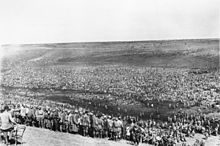
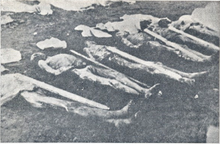
In early 1941, Germany began planningGeneralplan Ost,the genocide of Slavs in Eastern Europe which was supposed to start after a major expansion ofGerman concentration camps in occupied Polandand the fall of Stalin's regime.[37][41][42]This plan was to be carried out gradually over 25 to 30 years.[33][41]After an approximate 30 million[43]Slavs would be killed through starvation and their major cities depopulated, the Germans were supposed to repopulate Eastern Europe.[42][44][45]In June 1941, when Germany invaded the Soviet Union inOperation Barbarossa,Hitler paused the plan to focus on theextermination of the Jews.[45]However, some of the plan was nonetheless implemented. Millions of Slavs were murdered in Eastern Europe;[45]this includes victims of theHunger Plan,Germany's intentional starvation of the region,[43]as well as themurders of 3.3. million Soviet prisoners of war.[46]Germany'sHeinrich Himmleralso ordered his subordinateLudolf-Hermann von Alvenslebento start repopulatingCrimea,and hundreds of ethnic Germans were forcibly moved to cities and villages there.[47]The SovietRed Armytook back their land from the Germansin 1944.[45]Stephen J. Lee estimates that, by the end ofWorld War IIin 1945, the Russian population was about90 million fewerthan it could have been otherwise.[48]Also during World War II,fascist Italysent tens of thousands of Slavs toconcentration campsin mainland Italy,Libya,andthe Balkans,because Italian leaderBenito Mussolinialso had a hatred of them.[49]
In 1991, theSoviet Union collapsed,and many former Soviet republics became independent countries.[36][50]Currently, former Soviet states in Central Asia such asKazakhstanandKyrgyzstanhave very large minority Slavic populations, with most being Russians.[50]Kazakhstan has the largest Slavic minority population.[51]
Languages
[edit]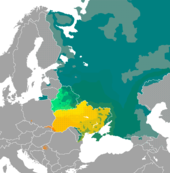
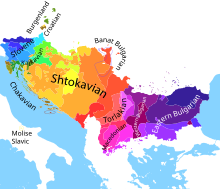

Proto-Slavic,the supposed ancestor language of all Slavic languages, is a descendant of commonProto-Indo-European,via aBalto-Slavic stagein which it developed numerous lexical and morphophonological isoglosses with theBaltic languages.In the framework of theKurgan hypothesis,"the Indo-Europeans who remained after the migrations [from the steppe] became speakers of Balto-Slavic".[52]
Proto-Slavic is defined as the last stage of the language preceding the geographical split of the historicalSlavic languages.That language was uniform, and on the basis of borrowings from foreign languages and Slavic borrowings into other languages, it cannot be said to have any recognizable dialects, which suggests that there was, at one time, a relatively-smallProto-Slavic homeland.[53]
Slavic linguistic unity was to some extent visible as late asOld Church Slavonic(orOld Bulgarian) manuscripts which, though based on local Slavic speech ofThessaloniki,could still serve the purpose of the first common Slavic literary language.[54]
StandardisedSlavic languages that have official status in at least one country are:Belarusian,Bosnian,Bulgarian,Croatian,Czech,Macedonian,Montenegrin,Polish,Russian,Serbian,Slovak,Slovene,andUkrainian.Russian is the most spoken Slavic language, and is the most spokennative languagein Europe.[55]
The Alpha bets used for Slavic languages are usually connected to the dominant religion among the respective ethnic groups. Orthodox Christians use theCyrillic Alpha betwhile Catholics use theLatin Alpha bet;the Bosniaks, who are Muslim, also use the Latin Alpha bet and Cyrillic Alpha bet in Serbia. Additionally, someEastern CatholicsandWestern Catholicsuse the Cyrillic Alpha bet. Serbian and Montenegrin use both the Cyrillic and Latin Alpha bets. There is also a Latin script to write in Belarusian, calledŁacinkaand in Ukrainian, calledLatynka.[citation needed]
Ethno-cultural subdivisions
[edit]West Slavsoriginate from early Slavic tribes which settled inCentral Europeafter theEast Germanic tribeshad left this area during themigration period.[56]They are noted as having mixed withGermanics,Hungarians,Celts(particularly theBoii),Old Prussians,and thePannonian Avars.[57]The West Slavs came under the influence of theWestern Roman Empire(Latin) and of theCatholic Church.[citation needed]
East Slavshave origins in early Slavic tribes who mixed and contacted withFinns,Balts[58][59]and with the remnants of the people of theGoths.[60]Their early Slavic component,Antes,mixed or absorbedIranians,and later received influence from theKhazarsandVikings.[61]The East Slavs trace their national origins to the tribal unions ofKievan Rus'andRus' Khaganate,beginning in the 10th century. They came particularly under the influence of theByzantine Empireand of theEastern Orthodox Church.[citation needed]
South Slavsfrom most of the region have origins in early Slavic tribes who mixed with the local Proto-Balkanic tribes (Illyrian,Dacian,Thracian,Paeonian,Hellenic tribes), andCeltic tribes(particularly theScordisci), as well as with Romans (and the Romanized remnants of the former groups), and also with remnants of temporarily settled invading East Germanic, Asiatic or Caucasian tribes such asGepids,Huns,Avars,Goths andBulgars.[citation needed]The original inhabitants of present-day Slovenia and continental Croatia have origins in early Slavic tribes who mixed with Romans and romanized Celtic and Illyrian people as well as with Avars and Germanic peoples (Lombards and East Goths). The South Slavs (except the Slovenes and Croats) came under the cultural sphere of theEastern Roman Empire(Byzantine Empire), of theOttoman Empireand of theEastern Orthodox ChurchandIslam,while the Slovenes and the Croats were influenced by theWestern Roman Empire(Latin) and thus by theCatholic Churchin a similar fashion to that of the West Slavs.[citation needed]
Genetics
[edit]Consistent with the proximity of their languages, analyses ofY chromosomes,mDNA,andautosomalmarker CCR5de132 shows thatEast SlavsandWest Slavsare genetically very similar, but demonstrating significant differences from neighboring Finno-Ugric,Turkic,and North Caucasian peoples. Such genetic homogeneity is somewhat unusual, given such a wide dispersal of Slavic populations.[62][63]Together they form the basis of the "East European"gene cluster,which also includes non-SlavicHungariansandAromanians.[62][64]
OnlyNorthern Russiansamong East and West Slavs belong to a different, "Northern European"genetic cluster, along withBalts,GermanicandBaltic Finnic peoples(Northern Russian populations are very similar to Balts).[65][66]
The 2006 Y-DNA study results "suggest that the Slavic expansion started from the territory of present-day Ukraine, thus supporting the hypothesis placing the earliest known homeland of Slavs in the basin of the middleDnieper".[67]According to genetic studies until 2020, the distribution, variance and frequency of theY-DNA haplogroupsR1aandI2and their subclades R-M558, R-M458 and I-CTS10228 amongSouth Slavscorrelate with the spread of Slavic languages during the medieval Slavic expansion from Eastern Europe, most probably from the territory of present-day Ukraine andSoutheastern Poland.[68][69][70][71][72][73][74]
Religion
[edit]
Thepagan Slavicpopulationswere Christianizedbetween the 7th and 12th centuries.Orthodox Christianityis predominant among East and South Slavs, whileCatholicismis predominant among West Slavs and some westernSouth Slavs.The religious borders are largely comparable to theEast–West Schismwhich began in the 11th century. Islam first arrived in the 7th century during theearly Muslim conquests,and was gradually adopted by a number of Slavic ethnic groups through the centuries in the Balkans.[citation needed]
Among Slavic populations who profess a religion, the majority of contemporary Christian Slavs are Orthodox, followed by Catholic. The majority of Muslim Slavs follow theHanafischool of theSunnibranch of Islam.[75]Religious delineations by nationality can be very sharp; usually in the Slavic ethnic groups, the vast majority of religious people share the same religion.[citation needed]
|
MainlyEastern Orthodoxy:[76][77] |
MainlyCatholicism:[citation needed] |
MainlyIslam:
|
Relations with non-Slavic people
[edit]Throughout their history, Slavs came into contact with non-Slavic groups. In the postulated homeland region (present-dayUkraine), they had contacts with the IranianSarmatiansand the GermanicGoths.After their subsequent spread, the Slavs began assimilating non-Slavic peoples. For example, in the Northern Black Sea region, the Slavs assimilated the remnants of the Goths.[84]In the Balkans, there werePaleo-Balkanpeoples, such as Romanized andHellenized(Jireček Line)Illyrians,ThraciansandDacians,as well asGreeksandCelticScordisciandSerdi.[85]Because Slavs were so numerous, most indigenous populations of the Balkans were Slavicized. Thracians and Illyrians mixed as ethnic groups in this period.
A notable exception is Greece, whereSlavs were HellenizedbecauseGreekswere more numerous, especially with more Greeks returning to Greece in the 9th century and the influence of the church and administration,[86]however, Slavicized regions withinMacedonia,ThraceandMoesia Inferioralso had a larger portion of locals compared to migrating Slavs.[87]Other notable exceptions are the territory of present-dayRomaniaandHungary,where Slavs settled en route to present-day Greece, North Macedonia, Bulgaria andEast Thracebut assimilated, and the modernAlbaniannation which claims descent from Illyrians and other Balkan tribes.[citation needed]
The status of theBulgarsas a ruling class and their control of the land nominally left their legacy in theBulgarian country and people,but Bulgars were gradually also Slavicized into the present-day South Slavic ethnic group known asBulgarians.TheRomance speakerswithinthe fortified Dalmatian citiesretained their culture and language for a long time.[88]Dalmatian Romance was spoken until the high Middle Ages, but, they too were eventually assimilated into the body of Slavs.[89]
In the Western Balkans, South Slavs and GermanicGepidsintermarried with invaders, eventually producing a Slavicized population.[citation needed]In Central Europe, the West Slavs intermixed withGermanic,Hungarian,andCelticpeoples, while in Eastern Europe the East Slavs had encounteredFinnicandScandinavian peoples.Scandinavians (Varangians) and Finnic peoples were involved in theearly formation of the Rus' statebut were completely Slavicized after a century. SomeFinno-Ugrictribes in the north were also absorbed into the expanding Rus population.[65]In the 11th and 12th centuries, constant incursions by nomadicTurkictribes, such as theKipchakand thePecheneg,caused a massive migration of East Slavic populations to the safer, heavily forested regions of the north.[90]In the Middle Ages, groups ofSaxonore miners settled in medievalBosnia,SerbiaandBulgaria,where they were Slavicized.[citation needed]

Saqalibarefers to the Slavicmercenariesandslavesin the medieval Arab world inNorth Africa,SicilyandAl-Andalus.Saqaliba served as caliph's guards.[91][92]In the 12th century,Slavic piracy in the Balticsincreased. TheWendish Crusadewas started against the Polabian Slavs in 1147, as a part of theNorthern Crusades.The pagan chief of the SlavicObodritetribes,Niklot,began his open resistance whenLothar III,Holy Roman Emperor,invaded Slavic lands. In August 1160, Niklot was killed, and German colonization (Ostsiedlung) of the Elbe-Oder region began. InHanoverian Wendland,Mecklenburg-VorpommernandLusatia,invaders startedgermanization.Early forms of germanization were described by German monks:Helmoldin the manuscriptChronicon SlavorumandAdam of BremeninGesta Hammaburgensis ecclesiae pontificum.[93]ThePolabian languagesurvived until the beginning of the 19th century in what is now the German state ofLower Saxony.[94]InEastern Germany,around 20% of Germans have historic Slavic paternal ancestry, as revealed in Y-DNA testing.[95]Similarly, in Germany, around 20% of the foreign surnames are of Slavic origin.[96]
Cossacks,although Slavic and practicingOrthodox Christianity,came from a mix of ethnic backgrounds, includingTatarsand other peoples.[citation needed]TheGoralsof southernPolandand northernSlovakiaare partially descended from the originally Balkan Romance speakingVlachs,who migrated into the region from the 14th to 17th centuries and were quickly absorbed into the local population, especially since the majority of Vlachs were alreadyslavicizedand the term became synonymous with Ruthenians. The populations ofMoravian Wallachia,Carpathian Rutheniaand parts of northern Slovakia are also descended partially from the Vlachs.[97][98][99]Conversely, some Slavs were assimilated into other populations. Although the majority continued towards Southeast Europe, attracted by the riches of the area that became the state of Bulgaria, a few remained in the Carpathian Basin in Central Europe and were assimilated into theMagyarpeople. Numerous rivers and places inRomaniahave a name with Slavic origins.[100]
Population
[edit]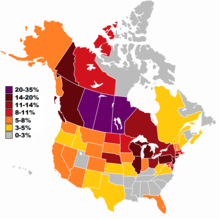

Winkler Prins(2002) estimated the number of Slavs worldwide to be aroundc.260 million at the time.[102][unreliable source?]Currently it is estimated that there are 300 million Slavic inhabitants inCentral,Eastern,andSoutheastern Europe.[103]
| Ethnicity | Estimates and census data | |
|---|---|---|
| Belarusians |
| |
| Bosniaks(previously called "Bosnian Muslims" ) |
| |
| Bulgarians |
| |
| Bunjevci |
| |
| Croats |
| |
| Czechs | ||
| Czechoslovaks(a supra-ethnic category of Czechs and Slovaks) | ||
| Gorani | ||
| Kashubians |
| |
| Macedonians |
| |
| Montenegrins | ||
| Moravians | ||
| Muslims (ethnic group)(a supra-ethnic category of Bosniaks, Gorani,Torbeši,Pomaks) | ||
| Poles |
| |
| Russians |
| |
| Rusyns (incl.Boykos,Lemkos,Hutsuls) |
||
| Serbs |
| |
| Silesians | ||
| Slavs(in the United States and Canada) | ||
| Slavs in Greece(also a sub-ethnic category of Macedonians and Bulgarians) | ||
| Slovaks |
| |
| Slovenes |
| |
| Sorbs |
| |
| Ukrainians |
| |
| Yugoslavs(a supra-ethnic category of Bosniaks, Croats, Macedonians, Montenegrins, Serbs and Slovenes) |
| |
Historiography
[edit]See also
[edit]Notes
[edit]- ^Originally Eastern Orthodox, with some groups adoptingByzantine-Rite Catholicismunder Polish and Austro-Hungarian rule and reverting to Eastern Orthodoxy starting in the late 19th Century.[citation needed]
- ^The 53,786 figure is the sum of 53,605 "Bosniaks" + 181 "Bosniaks-Muslims".[111][112]
- ^Including 16,000 single ethnic identity, 216,000 multiple ethnic identity Polish and Kashubian, 1,000 multiple ethnic identity Kashubian and another in Poland.[105]
- ^The 280,873 figure is the sum of 278,865 "Montenegrins" + 1,833 "Montenegrins-Serbs" + 175 "Montenegrins-Muslims".[111][112]
- ^The 20,977 figure is the sum of 20,537 "Muslims" + 183 "Muslims-Bosniaks" + 257 "Muslims-Montenegrins".[111][112]
- ^The 180,213 figure is the sum of 178,110 "Serbs" + 2,103 "Serbs-Montenegrins".[111][110]
References
[edit]Citations
[edit]- ^Kirch, Aksel (June 1992). "Russians as a Minority in Contemporary Baltic States".Bulletin of Peace Proposals.23(2).SAGE Publishing:205–212.doi:10.1177/096701069202300212.JSTOR44481642.S2CID157870839.
- ^Ramet, Pedro (1978). "Migration and Nationality Policy in Soviet Central Asia".Humboldt Journal of Social Relations.6(1).California State Polytechnic University, Humboldt:79–101.JSTOR23261898.
- ^"Geography and ethnic geography of the Balkans to 1500".25 February 1999. Archived fromthe originalon 25 February 1999.
- ^Encyclopædia Britannica (18 September 2006)."Slav (people) – Britannica Online Encyclopedia".Britannica.Retrieved18 August2010.
- ^Kamusella, Tomasz; Nomachi, Motoki; Gibson, Catherine (2016).The Palgrave Handbook of Slavic Languages, Identities and Borders.London: Palgrave Macmillan.ISBN978-1-137-34839-5.
- ^Serafin, Mikołaj (January 2015)."Cultural Proximity of the Slavic Nations"(PDF).Academia.Retrieved28 April2017.
- ^Živković, Tibor; Crnčević, Dejan; Bulić, Dejan; Petrović, Vladeta; Cvijanović, Irena; Radovanović, Bojana (2013).The World of the Slavs: Studies of the East, West and South Slavs: Civitas, Oppidas, Villas and Archeological Evidence (7th to 11th Centuries AD).Belgrade: Istorijski institut.ISBN978-86-7743-104-4.
- ^Gasparov, Boris; Raevsky-Hughes, Olga (2018).Christianity and the Eastern Slavs, Volume I: Slavic Cultures in the Middle Ages.Univ of California Press. pp. 120 & 124.ISBN978-0-520-30247-1.
- ^Stephen Barbour, Cathie Carmichael,Language and Nationalism in Europe,Oxford University Press, 2000, p. 199,ISBN0-19-823671-9
- ^Robert Bideleux; Ian Jeffries (January 1998).A History of Eastern Europe: Crisis and Change.Psychology Press. p. 325.ISBN978-0-415-16112-1.
- ^Procopius,History of the Wars,\,VII. 14. 22–30, VIII.40.5
- ^Jordanes,The Origin and Deeds of the Goths,V.33.
- ^Curta 2001,pp. 41–42, 50, 55, 60, 69, 75, 88.
- ^Balabanov, Kosta (2011).Vinica Fortress: mythology, religion and history written with clay.Skopje: Matica. pp. 273–309.
- ^Coon, Carleton S. (1939)The Peoples of Europe.Chapter VI, Sec. 7 New York: Macmillan Publishers.
- ^Tacitus.Germania,page 46.
- ^Curta 2001: 38. Dzino 2010: 95.
- ^Barford, Paul M (2001).The Early Slavs: Culture and Society in Early Medieval Eastern Europe.Cornell University Press.ISBN978-0-8014-3977-3.
- ^"Procopius, History of the Wars, VII. 14. 22–30".Clas.ufl.edu.Retrieved4 April2014.
- ^Jordanes,The Origin and Deeds of the Goths,V. 35.
- ^Maurice's Strategikon: handbook of Byzantine military strategy,trans. G.T. Dennis (1984), p. 120.
- ^Curta 2001,pp. 91–92, 315.
- ^Mallory & Adams "Encyclopedia of Indo-European Culture
- ^Curta, Florin (1 January 2024)."Migration and Common Slavic. Critical remarks of an archaeologist".Linguistica Brunensia.
- ^Cyril A. Mango (1980).Byzantium, the empire of New Rome.Scribner. p.26.ISBN978-0-684-16768-8.
- ^Tachiaos, Anthony-Emil N. 2001.Cyril and Methodius of Thessalonica: The Acculturation of the Slavs.Crestwood, NY: St. Vladimir's Seminary Press.
- ^Nystazopoulou-Pelekidou 1992:Middle Ages
- ^Štih, Peter (2010)."V. Wiped Out By The Slavic Settlement? The Issue Of Continuity Between Antiquity And The Early Middle Ages In The Slovene Area".The Middle Ages Between the Eastern Alps and the Northern Adriatic: Select Papers on Slovene Historiography and Medieval History.East Central and Eastern Europe in the Middle Ages. Vol. 2.Brill.pp. 85–99.doi:10.1163/ej.9789004185913.i-463.18.ISBN978-9-004-18770-2.
- ^Željko Rapanić; (2013) O početcima i nastajanju Dubrovnika (The origin and formation of Dubrovnik. additional considerations) p. 94; Starohrvatska prosvjeta, Vol. III No. 40,[1]
- ^During the reign ofHeraclius(r. 610–641).De Administrando Imperiochapter 30.
- ^Stergar, Rok (12 July 2017)."Panslavism".International Encyclopedia of the First World War.
- ^abStergar, Rok."Nationalities (Austria-Hungary)".International Encyclopedia of the First World War.
- ^abcMark Harrison (2002). "Accounting for War: Soviet Production, Employment, and the Defence Burden, 1940–1945".Cambridge University Press.p.167. ISBN 0-521-89424-7
- ^Rudnytskyi, Omelian et al. “The 1921–1923 Famine and the Holodomor of 1932–1933 in Ukraine: Common and Distinctive Features.”Nationalities Papers48.3 (2020): 549–568. Web.
- ^Livi-Bacci, Massimo (28 July 2021)."Nature, Politics, and the Traumas of Europe".Population and Development Review.47(3): 579–609.doi:10.1111/padr.12429.ISSN0098-7921.
- ^ab"Russia and Ukraine: the tangled history that connects—and divides—them".History.24 February 2023.Retrieved23 May2024.
- ^abcGwiazda II, Henry J. (2016)."The Nazi Racial War: Concentration Camps in the New Order".The Polish Review.61(3): 59–84.doi:10.5406/polishreview.61.3.0059.
- ^"Vocabulary Terms Related To The Holocaust - Holocaust Museum Houston".hmh.org.1 August 2023.Retrieved23 May2024.
- ^Kampor 1942-1943: Hrvati, Slovenci i Židovi u koncentracijskom logoru Kampor na otoku Rabu( "Kampor 1942-1943: Croats, Slovenes, and Jews in the Kampor concentration camp on the island of Rab" ). Rijeka: Adamic, 1998
- ^"Survivors of war camp lament Italy's amnesia - International Herald Tribune".20 October 2008. Archived fromthe originalon 20 October 2008.Retrieved23 May2024.
- ^abFritz, Stephen G. (2011).Ostkrieg: Hitler's War of Extermination in the East.University Press of Kentucky. Generalplan Ost (General plan for the east).ISBN978-0-8131-4050-6– via Google Books.
- ^ab"Remembrance of the Great Patriotic War and Russia's Invasion of Ukraine".The National WWII Museum | New Orleans.18 March 2022.Retrieved23 May2024.
- ^abBlakemore, Erin (21 February 2017)."The Nazis' Nightmarish Plan to Starve the Soviet Union".JSTOR Daily.Retrieved23 May2024.
- ^"History of Germany - Germany from 1871 to 1918 | Britannica".britannica.Retrieved23 May2024.
- ^abcdRubenstein, Joshua (26 November 2010)."The Devils' Playground".The New York Times.ISSN0362-4331.Retrieved23 May2024.
- ^"Nazi Persecution of Soviet Prisoners of War".encyclopedia.ushmm.org.Retrieved23 May2024.
- ^Berkhoff, Karel C.Central European History,vol. 39, no. 4, 2006, pp. 728–30.JSTOR,http:// jstor.org/stable/20457191. Accessed 23 May 2024.
- ^Stephen J. Lee (2000). "European dictatorships, 1918–1945".Routledge. p.86. ISBN 0-415-23046-2.
- ^"'The Italians hid behind Nazi crimes to forget their own and failed to firmly anchor democracy in their society'".Le Monde.fr.22 October 2022.Retrieved23 May2024.
- ^ab"Kyrgyzstan Offers an Unlikely Window Into Slavic Culture".The Moscow Times.10 December 2013.
- ^Russians left behind in Central Asia,by Robert Greenall,BBC News,23 November 2005.
- ^F. Kortlandt, The spread of the Indo-Europeans,Journal of Indo-European Studies,vol. 18 (1990), pp. 131–140. Online version, p. 4.
- ^F. Kortlandt, The spread of the Indo-Europeans,Journal of Indo-European Studies,vol. 18 (1990), pp. 131–140. Online version, p. 3.
- ^J.P. Mallory and D.Q. Adams,The Oxford Introduction to Proto-Indo-European and the Proto-Indo-European World(2006), pp. 25–26.
- ^"Russian".University of Toronto.Retrieved26 March2022.
Russian is the most widespread of the Slavic languages and the largest native language in Europe.
- ^Kobyliński, Zbigniew (1995). "The Slavs". InMcKitterick, Rosamond(ed.).The New Cambridge Medieval History: Volume 1, c.500-c.700.Cambridge University Press. p. 531.ISBN978-0-521-36291-7.
- ^Roman Smal Stocki (1950).Slavs and Teutons: The Oldest Germanic-Slavic Relations.Bruce.
- ^Raymond E. Zickel; Library of Congress. Federal Research Division (1 December 1991).Soviet Union: A Country Study.Federal Research Division, Library of Congress. p. 138.ISBN978-0-8444-0727-2.
- ^Comparative Politics.Pearson Education India. pp. 182–.ISBN978-81-317-6033-8.
- ^Tarasov I.M. On the Mention of the Dnieper Varangians in the Context of the Legend of the Beginning of Kiev. 2023. P. 59–60
- ^Vlasto 1970,p. 237.
- ^abVerbenko 2005,pp. 10–18.
- ^Balanovsky 2012,p. 13.
- ^Balanovsky 2012,p. 23.
- ^abBalanovsky & Rootsi 2008,pp. 236–250.
- ^Balanovsky 2012,p. 26.
- ^Rebała, K; Mikulich, AI; Tsybovsky, IS; Siváková, D; Dzupinková, Z; Szczerkowska-Dobosz, A; Szczerkowska, Z (2007)."Y-STR variation among Slavs: Evidence for the Slavic homeland in the middle Dnieper basin".Journal of Human Genetics.52(5): 406–14.doi:10.1007/s10038-007-0125-6.PMID17364156.
- ^A. Zupan; et al. (2013)."The paternal perspective of the Slovenian population and its relationship with other populations".Annals of Human Biology.40(6): 515–526.doi:10.3109/03014460.2013.813584.PMID23879710.S2CID34621779.
However, a study by Battaglia et al. (2009) showed a variance peak for I2a1 in the Ukraine and, based on the observed pattern of variation, it could be suggested that at least part of the I2a1 haplogroup could have arrived in the Balkans and Slovenia with the Slavic migrations from a homeland in present-day Ukraine... The calculated age of this specific haplogroup together with the variation peak detected in the suggested Slavic homeland could represent a signal of Slavic migration arising from medieval Slavic expansions. However, the strong genetic barrier around the area of Bosnia and Herzegovina, associated with the high frequency of the I2a1b-M423 haplogroup, could also be a consequence of a Paleolithic genetic signal of a Balkan refuge area, followed by mi xing with a medieval Slavic signal from modern-day Ukraine.
- ^Underhill, Peter A. (2015), "The phylogenetic and geographic structure of Y-chromosome haplogroup R1a",European Journal of Human Genetics,23(1): 124–131,doi:10.1038/ejhg.2014.50,PMC4266736,PMID24667786,
R1a-M458 exceeds 20% in the Czech Republic, Slovakia, Poland, and Western Belarus. The lineage averages 11–15% across Russia and Ukraine and occurs at 7% or less elsewhere (Figure 2d). Unlike hg R1a-M458, the R1a-M558 clade is also common in the Volga-Uralic populations. R1a-M558 occurs at 10–33% in parts of Russia, exceeds 26% in Poland and Western Belarus, and varies between 10 and 23% in the Ukraine, whereas it drops 10-fold lower in Western Europe. In general, both R1a-M458 and R1a-M558 occur at low but informative frequencies in Balkan populations with known Slavonic heritage.
- ^O.M. Utevska (2017).Генофонд українців за різними системами генетичних маркерів: походження і місце на європейському генетичному просторі[The gene pool of Ukrainians revealed by different systems of genetic markers: the origin and statement in Europe] (PhD) (in Ukrainian). National Research Center for Radiation Medicine ofNational Academy of Sciences of Ukraine.pp. 219–226, 302.
- ^Neparáczki, Endre; et al. (2019)."Y-chromosome haplogroups from Hun, Avar and conquering Hungarian period nomadic people of the Carpathian Basin".Scientific Reports.9(16569).Nature Research:16569.Bibcode:2019NatSR...916569N.doi:10.1038/s41598-019-53105-5.PMC6851379.PMID31719606.
Hg I2a1a2b-L621 was present in 5 Conqueror samples, and a 6th sample form Magyarhomorog (MH/9) most likely also belongs here, as MH/9 is a likely kin of MH/16 (see below). This Hg of European origin is most prominent in the Balkans and Eastern Europe, especially among Slavic speaking groups.
- ^Pamjav, Horolma; Fehér, Tibor; Németh, Endre; Koppány Csáji, László (2019).Genetika és őstörténet(in Hungarian). Napkút Kiadó. p. 58.ISBN978-963-263-855-3.
Az I2-CTS10228 (köznevén "dinári-kárpáti" ) alcsoport legkorábbi közös őse 2200 évvel ezelőttre tehető, így esetében nem arról van szó, hogy a mezolit népesség Kelet-Európában ilyen mértékben fennmaradt volna, hanem arról, hogy egy, a mezolit csoportoktól származó szűk család az európai vaskorban sikeresen integrálódott egy olyan társadalomba, amely hamarosan erőteljes demográfiai expanzióba kezdett. Ez is mutatja, hogy nem feltétlenül népek, mintsem családok sikerével, nemzetségek elterjedésével is számolnunk kell, és ezt a jelenlegi etnikai identitással összefüggésbe hozni lehetetlen. A csoport elterjedése alapján valószínűsíthető, hogy a szláv népek migrációjában vett részt, így válva az R1a-t követően a második legdominánsabb csoporttá a mai Kelet-Európában. Nyugat-Európából viszont teljes mértékben hiányzik, kivéve a kora középkorban szláv nyelvet beszélő keletnémet területeket.
- ^Fóthi, E.; Gonzalez, A.; Fehér, T.; et al. (2020), "Genetic analysis of male Hungarian Conquerors: European and Asian paternal lineages of the conquering Hungarian tribes",Archaeological and Anthropological Sciences,12(1): 31,Bibcode:2020ArAnS..12...31F,doi:10.1007/s12520-019-00996-0,
Based on SNP analysis, the CTS10228 group is 2200 ± 300 years old. The group's demographic expansion may have begun in Southeast Poland around that time, as carriers of the oldest subgroup are found there today. The group cannot solely be tied to the Slavs, because the proto-Slavic period was later, around 300–500 CE... The SNP-based age of the Eastern European CTS10228 branch is 2200 ± 300 years old. The carriers of the most ancient subgroup live in Southeast Poland, and it is likely that the rapid demographic expansion which brought the marker to other regions in Europe began there. The largest demographic explosion occurred in the Balkans, where the subgroup is dominant in 50.5% of Croatians, 30.1% of Serbs, 31.4% of Montenegrins, and in about 20% of Albanians and Greeks. As a result, this subgroup is often called Dinaric. It is interesting that while it is dominant among modern Balkan peoples, this subgroup has not been present yet during the Roman period, as it is almost absent in Italy as well (see Online Resource 5; ESM_5).
- ^Kushniarevich, Alena; Kassian, Alexei (2020),"Genetics and Slavic languages",in Marc L. Greenberg (ed.),Encyclopedia of Slavic Languages and Linguistics Online,Brill,doi:10.1163/2589-6229_ESLO_COM_032367,retrieved10 December2020,
The geographic distributions of the major eastern European NRY haplogroups (R1a-Z282, I2a-P37) overlap with the area occupied by the present-day Slavs to a great extent, and it might be tempting to consider both haplogroups as Slavic-specic patrilineal lineages
- ^Sabrina P. Ramet(1989).Religion and Nationalism in Soviet and East European Politics.Duke University Press. pp. 380–.ISBN978-0-8223-0891-1.
- ^Goldblatt, Harvey (December 1986). "Orthodox Slavic Heritage and National Consciousness: Aspects of the East Slavic and South Slavic National Revivals".Harvard Ukrainian Studies.10(3/4). Harvard Ukrainian Research Institute: 336–354.JSTOR41036261.
- ^Zdravkovski, Aleksander; Morrison, Kenneth (January 2014). "The Orthodox Churches of Macedonia and Montenegro: The Quest for Autocephaly".Religion and Politics in Post-Socialist Central and Southeastern Europe.pp. 240–262.doi:10.1057/9781137330727_10.ISBN978-1-349-46120-2.
- ^Sparrow, Thomas (16 June 2021)."Sorbs: The ethnic minority inside Germany".BBC.Retrieved3 April2022.
- ^Vučković, Marija (2008)."Savremena istraživanja malih etničkih zajednica"[Contemporary studies of small ethnic communities].XXI Vek(in Serbo-Croatian).3:2–8.Retrieved1 March2019.
- ^Lopasic, Alexander (1981). "Bosnian Muslims: A Search for Identity".British Society for Middle Eastern Studies.8(2).Taylor & Francis:115–121.doi:10.1080/13530198108705319.JSTOR194542.
- ^Hugh Poulton; Suha Taji-Farouki (January 1997).Muslim Identity and the Balkan State.Hurst. p. 33.ISBN978-1-85065-276-2.
- ^Bursać, Milan, ed. (2000),ГОРАНЦИ, МУСЛИМАНИ И ТУРЦИ У ШАРПЛАНИНСКИМ ЖУПАМА СРБИЈЕ: ПРОБЛЕМИ САДАШЊИХ УСЛОВА ЖИВОТА И ОПСТАНКА: Зборник радова са "Округлог стола" одржаног 19. априла 2000. године у Српској академији наука и уметности,Belgrade: SANU, pp. 71=73
- ^Kowan, J. (2000).Macedonia: The Politics of Identity and Difference.London: Pluto Press. p. 111.ISBN0-7453-1594-1.
- ^Tarasov I.M. On the Mention of the Dnieper Varangians in the Context of the Legend of the Beginning of Kiev. 2023. P. 59–60
- ^The Cambridge Ancient History,Volume 3, Part 2: The Assyrian and Babylonian Empires and Other States of the Near East, from the Eighth to the Sixth Centuries BC by John Boardman, I. E. S. Edwards, E. Sollberger, and N. G. L. Hammond,ISBN0-521-22717-8,1992, page 600: "In the place of the vanished Treres and Tilataei we find the Serdi for whom there is no evidence before the first century BC. It has for long being supposed on convincing linguistic and archeological grounds that this tribe was of Celtic origin."
- ^Fine 1991,p. 41.
- ^Florin Curta's An ironic smile: the Carpathian Mountains and the migration of the Slavs, Studia mediaevalia Europaea et orientalia. Miscellanea in honorem professoris emeriti Victor Spinei oblata, edited by George Bilavschi and Dan Aparaschivei, 47–72. Bucharest: Editura Academiei Române, 2018.
- ^Fine 1991,p. 35.
- ^Simmonds, Lauren (11 May 2023)."Croatian Language – The Difference between Dalmatic and Dalmatian".
- ^Klyuchevsky, Vasily (1987)."1: Mysl".The course of the Russian history(in Russian).ISBN5-244-00072-1.Retrieved9 October2009.
- ^Lewis (1994)."ch 1".Archived fromthe originalon 1 April 2001.
- ^Eigeland, Tor. 1976."The golden caliphate".Saudi Aramco World,September/October 1976, pp. 12–16.
- ^"Wend".Britannica.13 September 2013. Archived fromthe originalon 7 May 2008.Retrieved4 April2014.
- ^"Polabian language".Britannica.Retrieved4 April2014.
- ^"Contemporary paternal genetic landscape of Polish and German populations: from early medieval Slavic expansion to post-World War II resettlements".European Journal of Human Genetics.21(4): 415–22. 2013.doi:10.1038/ejhg.2012.190.PMC3598329.PMID22968131.
- ^"Y-chromosomal STR haplotype analysis reveals surname-associated strata in the East-German population".European Journal of Human Genetics.14(5): 577–582. 2006.doi:10.1038/sj.ejhg.5201572.PMID16435000.
- ^"Wołoscy pasterze w Ochotnicy oraz tutejsze nazwy pochodzenia wołoskiego".skansen-studzionki.pl(in Polish).Retrieved29 March2024.
- ^Redakcja (23 November 2017)."Skąd pochodzą górale? Inwazja Wołochów zmieniła historię polskich gór".Nasza Historia(in Polish).Retrieved29 March2024.
- ^Magocsi, Paul Robert (2015).With their backs to the mountains: a history of Carpathian Rus' and Carpatho-Rusyns.Budapest: Central European University Press.ISBN978-615-5053-46-7.
- ^Nandriș, Grigore (June 1956). "The Relations between Toponymy and Ethnology in Rumania".The Slavonic and East European Review.34(83).Modern Humanities Research Association:490–494.JSTOR4204755.
- ^"EAll- Russian population census 2010 – Population by nationality, sex and subjects of the Russian Federation".Demoscope Weekly.2010.
- ^"Slaven".EncartaEncyclopedieWinkler Prins(in Dutch). Microsoft Corporation/Het Spectrum. 1993–2002.
- ^Loginova, Nina N.; Radovanović, Milan M.; Yamashkin, Anatoliy A.; Vasin, Goran; Petrović, Marko D.; Demirović Bajrami, Dunja (31 December 2020)."Analysis of the population dynamics in the" Slavic World "with a special focus on Russia".Indonesian Journal of Geography.52(3): 317.doi:10.22146/ijg.51202.ISSN2354-9114.
- ^"Changes in the populations of the majority ethnic groups".belstat.gov.by.Archived fromthe originalon 28 July 2016.Retrieved28 July2016.
- ^abcdefghGłówny Urząd Statystyczny (January 2013).Ludność. Stan i struktura demograficzno-społeczna[Narodowy Spis Powszechny Ludności i Mieszkań 2011](PDF)(in Polish). Główny Urząd Statystyczny. pp. 89–101.Retrieved12 December2014.
- ^abcdefghijklmnop"Immigration and Ethnocultural Diversity Highlight Tables (2016 Canadian census)".Statistics Canada. 25 October 2017.Archivedfrom the original on 27 October 2017.
- ^abc"Socio-Economic Audit of Sarajevo Macro Region"(PDF).March 2004. Archived fromthe original(PDF)on 27 February 2007.Retrieved8 March2020.
- ^This number is derived from the 2022 total population estimate of 3,816,459, multiplied by 0.501 based on the 2013 50.1% Bosniak share estimate. It is not certain that the Bosniak share was still 50.1% in 2022. TheFactbooknotes: "Republika Srpska authorities dispute the methodology and refuse to recognize the results.""Bosnia and Herzegovina - the World Factbook".18 August 2022.
- ^abcdefghijklm"Final results of the Census of Population, Households and Dwellings, 2022".Statistical Office of the Republic of Serbia. 28 April 2023.Retrieved28 April2023.
- ^abcdefĐečević, Vuković-Ćalasan & Knežević 2017,p. 143.
- ^abcde"Stanovništvo Crne Gore prema polu, tipu naselja, nacionalnoj, odnosno etničkoj pripadnosti, vjeroispovijesti i maternjem jeziku po opštinama u Crnoj Gori"[Population of Montenegro by sex, type of settlement, national or ethnic affiliation, religion and mother tongue by municipalities in Montenegro](PDF)(in Montenegrin and English).Retrieved19 August2022.
- ^abcdĐečević, Vuković-Ćalasan & Knežević 2017,p. 144.
- ^abc"Census of population in the Republic of Macedonia 2002"(PDF).stat.gov.mk.(page 62)
- ^Kolev, Yordan, Българите извън България 1878 – 1945, 2005, р. 18Quote: "В началото на XXI в. общият брой на етническите българи в България и зад граница се изчислява на около 10 милиона души./At the beginning of the 21st century, the total number of ethnic Bulgarians in Bulgaria and abroad was estimated at about 10 million people."
- ^abThe Report: Bulgaria 2008.Oxford Business Group. 2008. pp. 7–8.ISBN978-1-902339-92-4.Retrieved26 March2016.
- ^Cole, Jeffrey E.(25 May 2011).Ethnic Groups of Europe: An Encyclopedia.Abc-Clio.ISBN978-1-59884-303-3.
{{cite book}}:|work=ignored (help) - ^Danver, Steven L. (10 March 2015).Native Peoples of the World.Routledge.ISBN978-1-317-46400-6.
{{cite book}}:|work=ignored (help) - ^Palermo, Francesco (2011)."National Minorities in Inter-State Relations: Filling the Legal Vacuum?".In Francesco Palermo (ed.).National Minorities in Inter-State Relations.Natalie Sabanadze. Martinus Nijhoff Publishers. p. 11.ISBN978-90-04-17598-3.
- ^Daphne Winland (2004), "Croatian Diaspora", in Melvin Ember; Carol R. Ember; Ian Skoggard (eds.),Encyclopedia of Diasporas: Immigrant and Refugee Cultures Around the World. Volume I: Overviews and Topics; Volume II: Diaspora Communities,vol. 2 (illustrated ed.),Springer Science+Business,p. 76,ISBN978-0-306-48321-9,
It is estimated that 4.5 million Croatians live outside Croatia...
- ^"Hrvatski Svjetski Kongres".Archived fromthe originalon 23 June 2003.Retrieved1 June2016.,Croatian World Congress, "4.5 million Croats and people of Croatian heritage live outside of the Republic of Croatia and Bosnia and Herzegovina"
- ^An estimated 57.3% ethnic Czechs (2021) on an estimated 10,705,384 total population (2022) makes about 6.1 million. However, 31.6% was unspecified, so this may be far off the real figure."Czech Republic".CIA - The World Factbook.Retrieved16 August2022.
- ^abcd"Tab. 6.2 Obyvatelstvo podle národnosti podle krajů"[Table. 6.2 Population by nationality, by region](PDF).Czech Statistical Office(in Czech). 2011. Archived fromthe original(PDF)on 31 January 2012.
- ^abcd"Ethnic composition of Slovakia 2021".Retrieved5 July2022.
- ^abc"2010 American Community Survey".American FactFinder.2010. Archived fromthe originalon 18 January 2015.Retrieved18 August2022.
- ^"Program političke stranke GIG".
Do Nato intervencije na Srbiju, 24.03.1999.godine, u Gori je živelo oko 18.000 Goranaca. U Srbiji i bivšim jugoslovenskim republikama nalazi se oko 40.000 Goranaca, a značajan broj Goranaca živi i radi u zemljama Evropske unije i u drugim zemljama. Po našim procenama ukupan broj Goranaca, u Gori u Srbiji i u rasejanju iznosi oko 60.000.
- ^Kwidzińska, Sławina (2007).The Kashubs Today: Culture — Language — Identity(PDF).Gdańsk: The Kashubian Institute. pp. 34–35.ISBN978-83-89079-78-7.Archived fromthe original(PDF)on 4 March 2016.Retrieved19 August2022.
- ^ab[ "Polen-Analysen. Die Kaschuben" (PDF). Länder-Analysen (in German). Polen NR. 95: 10–13. September 2011.http:// laender-analysen.de/polen/pdf/PolenAnalysen95.pdf]
- ^Topolinjska, Z. (1998), "In place of a foreword: facts about the Republic of Macedonia and the Macedonian language",International Journal of the Sociology of Language(131): 1–11,doi:10.1515/ijsl.1998.131.1,S2CID143257269
- ^"Širom svijeta pola miliona Crnogoraca".RTCG - Radio Televizija Crne Gore - Nacionalni javni servis.20 September 2014.Retrieved18 August2022.
- ^"Census of Population, Households and Dwellings in Bosnia and Herzegovina – Ethnicity/national affiliation, religion and mother tongue (Popis 2013 BiH)".popis.gov.ba.2019.Retrieved18 August2022.
- ^Including 36,522,000 single declared ethnic identity, 871,000 multiple declared ethnic identities (Polish and another ethnic identity, especially 431,000 Polish and Silesian, 216,000 Polish and Kashubian and 224,000 Polish and another identity)."Przynależność narodowo-etniczna ludności – wyniki spisu ludności i mieszkań 2011"(PDF).stat.gov.pl.29 January 2013.Retrieved16 August2022.
- ^Struktura narodowo-etniczna, językowa i wyznaniowa ludności Polski [Narodowy Spis Powszechny Ludności i Mieszkań 2011](PDF)(in Polish). Warsaw: Główny Urząd Statystyczny. November 2015. pp. 129–136.ISBN978-83-7027-597-6.
- ^Świat Polonii, witryna Stowarzyszenia Wspólnota Polska: "Polacy za granicą"Archived8 September 2015 at theWayback Machine(Polish people abroadas per summary by Świat Polonii, internet portal of the associationWspólnota Polska)
- ^"Russische Federatie – feiten en cijfers".EncartaEncyclopedieWinkler Prins(in Dutch). Microsoft Corporation/Het Spectrum. 1993–2002.
- ^Magocsi, Paul Robert(1995)."The Rusyn Question".Political Thought.2–3(6): 221–231.
- ^abcTheodore E. Baird and Amanda Klekowski von Koppenfels (May 2014)."Svaki drugi Srbin živi izvan Srbije"(PDF).Novosti. p. 5. Archived fromthe original(PDF)on 18 October 2012.Retrieved31 May2018.
- ^"The Institute for European Studies, Ethnological institute of UW"(PDF).Retrieved16 August2012.
- ^"UCLA Language Materials Project: Language Profile".Lmp.ucla.edu. Archived fromthe originalon 9 February 2011.Retrieved4 September2015.
- ^Poulton, Hugh (1995).Who are the Macedonians?.C. Hurst & Co. Publishers. p. 167.ISBN1-85065-238-4.
As often occurs with Yugoslav sources, there appears to be confusion about the numbers as there is about the numbers of Macedonians in Greek Macedonia at present: some Yugoslav sources put the latter figure at 350,000 but more sober estimates put it at 150–200,000.
- ^ab"National Conflict in a Transnational World: Greeks and Macedonians at the CSCE".Gate.net. Archived fromthe originalon 24 September 2015.Retrieved4 September2015.
- ^"Greece".State.gov. 4 March 2002.Retrieved4 September2015.
- ^"Základné údaje zo sčítania obyvateľov, domov a bytov 2011"[Basic data from the 2011 Census of Population, Houses and Apartments](PDF).statistics.sk(in Slovak). Statistical Office of the Slovak Republic. July 2012. Archived fromthe original(PDF)on 14 November 2012.Retrieved18 August2022.
- ^abcdZupančič, Jernej (August 2004)."Ethnic Structure of Slovenia and Slovenes in Neighbouring Countries"(PDF).Slovenia: a geographical overview.Association of the Geographic Societies of Slovenia.Retrieved18 August2022.
- ^Chambers, Madeline (26 November 2007)."Germany's Sorb minority struggles for survival".Reuters.Retrieved18 August2022.
- ^Paul R. Magocsi (2010).A History of Ukraine: The Land and Its Peoples.University of Toronto Press. pp. 10–.ISBN978-1-4426-1021-7.
- ^abcVic Satzewich (2003).The Ukrainian Diaspora.Routledge. pp. 19–21.ISBN978-1-134-43495-4.
- ^"Situation Ukraine Refugee Situation".data.unhcr.org.Retrieved18 August2022.
- ^"2021 American Community Survey 1-Year Estimates".American Community Survey2021.United States Census Bureau.Archived fromthe originalon 8 April 2022.Retrieved19 November2022.
- ^"Fact sheets: Ancestry – Serbian".Australian Bureau of Statistics.20 September 2016.Retrieved30 July2023.
- ^"Popis stanovništva, domaćinstava i stanova u Bosni i Hercegovini - Etnička/nacionalna pripadnost, vjeroispovjest i maternji jezik"[Census of population, households and dwellings in Bosnia and Herzegovina - Ethnic/national affiliation, religion and mother tongue](PDF).Agency for Statistics of Bosnia and Herzegovina. 2019. p. 27.
Sources
[edit]- Primary sources
- Moravcsik, Gyula,ed. (1967) [1949].Constantine Porphyrogenitus: De Administrando Imperio(2nd revised ed.). Washington D.C.: Dumbarton Oaks Center for Byzantine Studies.ISBN978-0-88402-021-9.
- Scholz, Bernhard Walter, ed. (1970).Carolingian Chronicles: Royal Frankish Annals and Nithard's Histories.University of Michigan Press.ISBN978-0-472-06186-0.
- Secondary sources
- Allentoft, ME (11 June 2015)."Population genomics of Bronze Age Eurasia".Nature.522(7555).Nature Research:167–172.Bibcode:2015Natur.522..167A.doi:10.1038/nature14507.PMID26062507.S2CID4399103.
- Balanovsky, Oleg; Rootsi, Siiri; et al. (January 2008)."Two sources of the Russian patrilineal heritage in their Eurasian context".American Journal of Human Genetics.82(1): 236–250.doi:10.1016/j.ajhg.2007.09.019.PMC2253976.PMID18179905.
- Balanovsky, Oleg P. (2012).Изменчивость генофонда в пространстве и времени: синтез данных о геногеографии митохондриальной ДНК и Y-хромосомы[Variability of the gene pool in space and time: synthesis of data on the genogeography of mitochondrial DNA and Y-chromosome](PDF)(Dr. habil. in Biology thesis) (in Russian). Moscow:Russian Academy of Medical Sciences.
- Barford, Paul M. (2001).The Early Slavs: Culture and Society in Early Medieval Eastern Europe.Ithaca, NY: Cornell University Press.ISBN978-0-8014-3977-3.
- Curta, Florin(2001).The Making of the Slavs: History and Archaeology of the Lower Danube Region, c. 500–700.Cambridge: Cambridge University Press.ISBN978-1-139-42888-0.
- Curta, Florin(2006).Southeastern Europe in the Middle Ages, 500–1250.Cambridge: Cambridge University Press.ISBN978-0-521-81539-0.
- Curta Florin,The early Slavs in Bohemia and Moravia: a response to my critics
- Đečević, Mehmed; Vuković-Ćalasan, Danijela; Knežević, Saša (2017)."Re-designation of Ethnic Muslims as Bosniaks in Montenegro".East European Politics and Societies.31(1): 137–157.doi:10.1177/0888325416678042.S2CID152238874.Retrieved18 August2022.
- Dvornik, Francis(1962).The Slavs in European History and Civilization.New Brunswick: Rutgers University Press.ISBN978-0-8135-0799-6.
- Fine, John Van Antwerp Jr.(1991) [1983].The Early Medieval Balkans: A Critical Survey from the Sixth to the Late Twelfth Century.Ann Arbor, Michigan: University of Michigan Press.ISBN978-0-472-08149-3.
- Fine, John Van Antwerp Jr.(1994) [1987].The Late Medieval Balkans: A Critical Survey from the Late Twelfth Century to the Ottoman Conquest.Ann Arbor, Michigan: University of Michigan Press.ISBN978-0-472-08260-5.
- Lacey, Robert. 2003.Great Tales from English History.Little, Brown and Company. New York.ISBN0-316-10910-X.
- Lewis, Bernard.Race and Slavery in the Middle East.Oxford Univ. Press.
- Mathieson, Iain (21 February 2018)."The Genomic History of Southeastern Europe".Nature.555(7695).Nature Research:197–203.Bibcode:2018Natur.555..197M.doi:10.1038/nature25778.PMC6091220.PMID29466330.
- Nystazopoulou-Pelekidou, Maria. 1992.The "Macedonian Question": A Historical Review.© Association Internationale d'Etudes du Sud-Est Europeen (AIESEE, International Association of Southeast European Studies), Comité Grec. Corfu: Ionian University. (English translation of a 1988 work written in Greek.)
- Obolensky, Dimitri(1974) [1971].The Byzantine Commonwealth: Eastern Europe, 500–1453.London: Cardinal.ISBN978-0-351-17644-9.
- Ostrogorsky, George(1956).History of the Byzantine State.Oxford: Basil Blackwell.
- Rębała, Krzysztof,et al..2007.Y-STR variation among Slavs: evidence for the Slavic homeland in the middle Dnieper basin.Journal of Human Genetics,May 2007, 52(5): 408–414.
- Verbenko, Dmitry A.; et al. (2005). "Variability of the 3'ApoB Minisatellite Locus in Eastern Slavonic Populations".Human Heredity.60(1): 10–18.doi:10.1159/000087338.PMID16103681.S2CID8926871.
- Vlasto, Alexis P.(1970).The Entry of the Slavs into Christendom: An Introduction to the Medieval History of the Slavs.Cambridge: Cambridge University Press.ISBN978-0-521-07459-9.
Further reading
[edit]- "Linguistic Marginalia on Slavic Ethnogensis"(PDF).Sorin Palgia,University of Bucharest.
External links
[edit]- Mitochondrial DNA Phylogeny in Eastern and Western Slavs, B. Malyarchuk, T. Grzybowski, M. Derenko, M. Perkova, T. Vanecek, J. Lazur, P. Gomolcaknd I. Tsybovsky, Oxford Journals(archived 14 June 2010)
 Texts on Wikisource:
Texts on Wikisource:
- "Slavs".Encyclopedia Americana.1920.
- "Slavs".The New Student's Reference Work.1914.
- Leopold Lénard (1913). "The Slavs".In Herbermann, Charles (ed.).Catholic Encyclopedia.New York: Robert Appleton Company.

